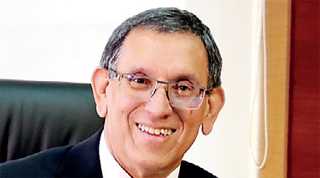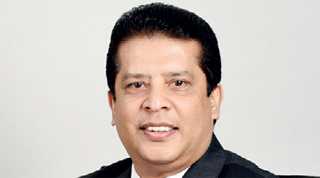Monday Nov 17, 2025
Monday Nov 17, 2025
Thursday, 21 February 2019 02:31 - - {{hitsCtrl.values.hits}}
DFCC Bank has reported a Profit before Tax of Rs. 4,233 million and a Profit after Tax of Rs. 2,768 million for the year ended 31 December 2018.
This compares with a Profit before Tax of Rs. 5,792 million and a Profit after Tax of Rs. 4,415 million in the previous year. However, the profit for 2018 includes the one-off fair value loss on Commercial Bank shares transferred to the trading portfolio and the Debt repayment levy (DRL) imposed on the value addition on financial services in the current year while the profit for 2017 includes a gain from the sale of Commercial Bank shares. Therefore, when the loss and gain on account of the Commercial Bank shares and the DRL are eliminated for an equitable comparison, the resultant Profit after Tax was Rs. 3,851 million for 2018 and Rs. 3,498 million for 2017. Accordingly, the 2018 performance represents a profit growth of 10% over that in 2017.
 |
Chairman Royle Jansz |
 |
CEO Lakshman Silva |
The Group recorded a profit before tax of Rs. 4,676 million and profit after tax of Rs. 3,070 million for the year ended 31 December 2018 as compared to Rs. 5,891 million and Rs. 4,434 million respectively in 2017. All members of the DFCC Group made positive and improved contributions to this performance.
Operating income
Following a judicious growth strategy which took into consideration the challenging environment faced by the country, DFCC recorded a year-on-year growth of 17% in its net portfolio which when coupled with prudent management of asset and liability pricing, enabled the Bank to post an increase of 9% in Net Interest Income to Rs. 12,414 million from Rs. 11,342 million in the previous year. The interest margin has decreased slightly to 3.5% from 3.6% in 2017. This performance is creditable given the stringent non-recognition of interest income on credit impaired loans. Further, a growth of 26% was recorded in fees and commission income to Rs. 2,013 million from Rs. 1,591 million in December 2017. This is the outcome of a focus on non-funded business.
Operating expenses
As part of its growth strategy, DFCC continuously invests in its organisation and infrastructure. The Bank increased its island-wide footprint by extending the branch network and added ten full service branches during the year. At the same time, DFCC enhanced its delivery channels through IT system upgrades and the introduction of pioneering, digitally enabled products. The Bank also continued to invest in its brand and franchise, which supported the increase in its deposit and asset base. The outlay on these investments resulted in a moderate increase of 14% in Operating Expenses to Rs. 6,672 million from Rs. 5,870 million in the previous year.
Impairment
Although the individual impairment provision increased due to a few specific exposures, the overall impairment provision during the year decreased. Moreover, recovery processes are being rigorously pursued to minimise any actual losses that may arise from the specific exposures.
DFCC’s NPL ratio moved up to 3.28% as at 31 December 2018 from 2.77% in December 2017. This reflected an industry-wide trend, which was consequent to the challenging business environment that prevailed during the year. The ratio has however been managed at a level below the industry average of 3.4% as at December 2018.
Other comprehensive income
Investments in equity securities and treasury bills and bonds are classified as financial assets whose variations in fair value are recorded through Other Comprehensive Income. Accordingly, fair value losses of Rs. 1,951 million and Rs. 1,371 million were recorded on account of equity securities and fixed income securities respectively. Prices of equity securities were affected by the declining trend in the share market, while prices of treasury bills and bonds were impacted by taxes implemented in April 2018.
Statement of financial position
Reflecting its measured growth strategy, DFCC’s Total Assets grew by Rs. 41,800 million to Rs. 374,908 million, which is a 13% growth on 31 December 2017. Within this, the Bank’s loan portfolio grew by Rs. 36,058 million to Rs. 249,734 million compared to Rs. 213,676 million as at 31 December 2017, which is a growth of 17%. This growth is commendable given that the adoption of SLFRS 9 resulted in an additional provision to the portfolio. The Bank lent prudently and did not pursue aggressive growth particularly to sectors that exhibited stress.
DFCC’s deposit base experienced a substantial growth of 25% recording an increase of Rs. 48,930 million to Rs. 242,238 million from Rs. 193,308 million as at 31 December 2017. This is not only a reflection of customers’ confidence in the Bank, but also the outcome of the investment in developing distribution channels and marketing innovative new products. With this deposit growth the Bank was able to report an improved loans to deposit ratio of 103% from 110% in December 2017.The Bank’s CASA ratio, which represents the proportion of low cost deposits in the total deposits of the Bank, was 21.8% as at 31 December 2018. Funding costs for DFCC were also contained due to access to medium to long term concessionary credit lines. When these concessionary term borrowings are added to deposits, the ratio improved to 28.6% as at 31 December 2018.
DFCC Bank, throughout its history, has been a prudent lender. Therefore, in order to support future growth and to maintain its premier development banking focus, the Bank has consistently maintained a capital ratio above the Basel III minimum capital requirements. As at 31st December 2018, the Group’s Tier 1 capital adequacy ratio stood at 10.888% while the total capital adequacy ratio was 16.168%. On a solo basis, as at 31st December 2018, DFCC recorded Tier 1 and total capital adequacy ratios of 10.766% and 16.065% respectively. These ratios are well above the minimum regulatory requirements of 8.5% and 12.5% effective 2019.
DFCC Bank was recognised as one of the Top 10 Most Admired Companies in Sri Lanka in 2018 by the Chartered Institute of Management Accountants and the International Chamber of Commerce Sri Lanka. This is a testament to the Bank’s superior customer service, financial stability, ethical practices and contribution towards the economy over the past sixty three years.